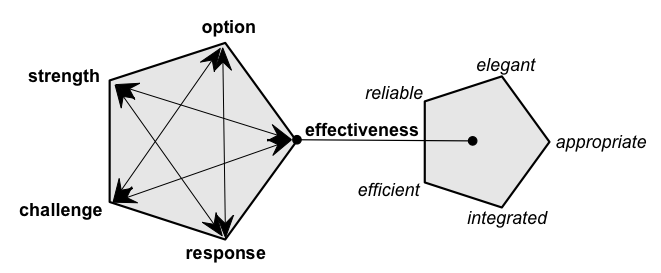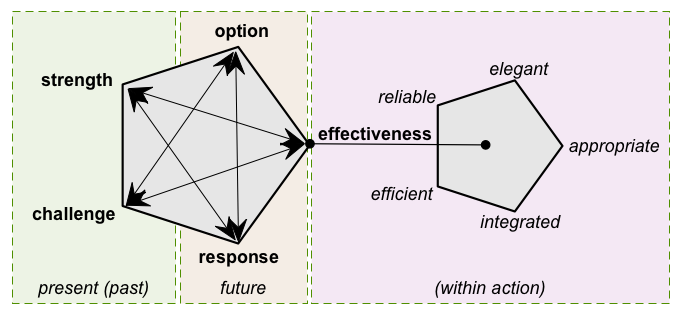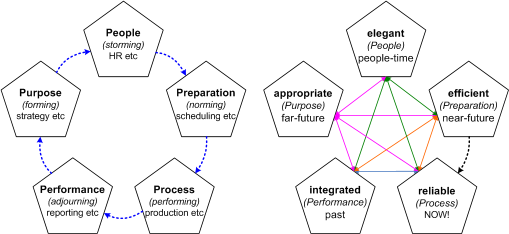Checking the SCORE
What’s a quick, practical alternative to SWOT – one that gives a bit more depth for strategic assessment, yet is still just as fast to use?
My answer? Check out the SCORE: Strengths, Challenges, Options, Responses, Effectiveness.
What triggered this one off was that in the past couple of weeks I’ve seen quite a few enterprise-architecture folks talking about using SWOT for basic strategy assessment. Well, yeah, it’s fine as far as it goes, but to my mind it really isn’t good enough for the job – at times so much ‘not good enough’ that it can be seriously misleading.
Which is why, about a dozen years back, I did a serious rethink around SWOT, and came up with SCORE as a more versatile and sensemaking-oriented replacement. It’s described in depth in my book SEMPER and SCORE, but I thought it might be useful to summarise it here.
A bit of background
SWOT has been around for decades, of course. It’s easy to understand, based on a simple two-axis matrix of ‘good versus bad’ and ‘inside versus outside’, giving us four quadrants:
- Strengths (good/inside)
- Weaknesses (bad/inside)
- Opportunities (good/outside)
- Threats (bad/outside)
And SWOT is easy to use – little more than a tick-the-boxes method, creating lists in the respective categories, then have a brief think about how each might impact on strategy.
Yet it does have some serious limitations, particularly at the larger scale, such as for enterprise-architecture and the like:
- Pejorative terminology: ‘weakness’ implies inadequacy, “not good enough”; ‘threat’ introduces a spurious sense of danger
- Arbitrary boundaries between ‘good’ and ‘bad’, ‘inside’ and ‘outside: tends to promote an ‘us versus them’ attitude, not well suited for assessment where boundaries blur, such as community partnerships, end-to-end networks, value webs
- Local optimisation: Issues tend to be viewed in isolation strategy for this issue only, ignoring its broader context
- Lack of longer-term continuity: Tends to be used ‘once-off’, then forgotten – may be repeated, but repetitions rarely linked
If we were to rethink SWOT, some of the things we’d need would include:
- Make the language more real – not ‘weaknesses’ or ‘threats’
- Adapt for use in broader, more complex contexts such as multi-organisation partnerships, or value-webs – boundaries may blur
- Adapt for a more holistic view – how does each asset or concern interact with others?
- Enhance the methodology – assess impact on overall effectiveness; iterative review with qualitative / quantitative scores; ‘before and after’ comparison of reviews and scores
Any rework needs to encapsulate all of this additional richness, yet still be as simple and quick to use as is SWOT.
That’s what I’d aimed to do with the design for SCORE.
Moving to SCORE
Like SWOT, we’d use SCORE for quick assessment of strategy and tactics. Unlike SWOT, one of the aims is that the results should be measurable – hence “What’s the SCORE?” And also unlike SWOT, we’d aim to assess both before and after the action – so as to support continuous improvement.
The reworked dimensions are as follows:
- Strengths / services / support: existing capabilities and resources, and/or potential for new synergies and affordances
- Challenges / constraints / capabilities needed: concerns that indicate needed capabilities and resources
- Options / opportunities and risks: opportunity is also risk, risk is also opportunity
- Responses / returns / rewards: probable or emergent consequences of action or inaction
- Effectiveness: related dimensions for impact on effectiveness in the context – efficient, reliable, elegant, appropriate, integrated
Perhaps the key difference from SWOT is that, rather than just parking concerns into categories, we bounce around between each of the different dimensions – an item in one dimension leading us to another item in one of the other dimensions, and so on – helping us build a richer picture of the overall context-space. We can show this ‘bouncing-around’ in visual form:
In SCORE, by intent, SWOT’s arbitrary notions of ‘good’ (Strengths, Opportunities) and ‘bad’ (Weaknesses, Threats) are thinned right down, to more of a sense of ‘what is available to us’ (Strength, Option) versus ‘what may need to be resolved’ (Challenge, Response). ‘Good’ and ‘bad’ are not arbitrary-absolutes – as they are in SWOT – but interpretations of something that’s highly contextual and can vary dynamically within that context: for example, a Strength can easily become ‘bad’ in practice if it prevents us from seeing an opportunity or risk (Option or Response).
In the same way, the SWOT boundary between ‘inside’ (Strengths, Weaknesses) and ‘outside’ (Opportunities, Threats) becomes much more blurred: SCORE’s Options and Responses could as easily come from inside the organisation, whereas Strengths and Challenges could as much come from sort-of-outside, in our relations with our partners and other stakeholders. Perhaps the real key here – and which also links it to Effectiveness and its sub-dimensions – is an emphasis on time-perspectives:
- present/past: Strength and Challenge look at what exists or now, or may be carried through as legacy from the past
- future: Option and Response look at what is desired in the future, or may impact us in the future
- within action: Effectiveness looks at the implications and cross-dependencies as we put into action the bridge between present and future
Or, to put these time-perspectives in visual form:
In essence, SCORE is (intentionally) much the same as SWOT, but with a few important extra twists in each of the original’s focus-areas, and with an extra dimension to link the discussion of strategy more solidly back into the real-world. In other words, the usage for SCORE is much the same as for SWOT – but it’s much richer, much more versatile, and much more capable.
SCORE dimensions
A bit more detail on each of the dimensions in SCORE: the kinds of questions we might ask, and the outcomes we seek from those questions. As above, these in turn should typically lead to further questions, either in the current dimension, or bouncing off to another dimension, for as long as seems appropriate for the need.
We should probably also aim to document what we find out as a result of these questions, and the choices that we would make as a result of what we find – models as decision-records. For a quick on-the-spot SCORE-assessment, these might just take the form of a few scrawled notes on the whiteboard, but for a more systematic and larger-scale process we would probably aim to develop more formal documentation: I’ve listed the typical documentation-types in each case for each dimension.
Strengths
This is much the same as for the Strengths quadrant in SWOT: in essence, “What do we have that we can use?” Typical questions would include:
- Strengths: What would we regard as our strengths in this?
- Services: What services and capabilities do we have? What services can we call on from others?
- Support: What support-resources do we have available to us? What support do we have, from others?
The responses to those questions should provide us with an inventory of what we have available to us to respond to opportunities and other options, and to support the change-roadmap that we’d develop going forward from here.
Deliverables would include: inventory of capabilities and services; support / partner-map.
Challenges
This is similar to the Weaknesses quadrant in SWOT, but with a few somewhat-subtle yet crucial differences. One is that this isn’t about ‘weaknesses’ in any pejorative sense: we will often be ‘weak’ in some area that isn’t actually relevant to the issues at hand. What should concern us here is about what we’d need to develop or change in order to respond to the issue at hand, and why we’d need to do that change. Typical questions here would include:
- Challenges: What are the issues we need to address? – within the organisation? – in relationships with partners, suppliers, other stakeholders?
- Constraints: What holds us back? What would constrain us to prevent any needed change? How will we resolve or work around those constraints?
- Capabilities needed: What new capabilities and services would we need? What skills would be required? What would be needed to develop these skills and services?
The responses here should provide us with content and priorities for the change-roadmap, and also help identify the internal project-risks.
Deliverables would include: prioritised roadmap for change; risks / issues register.
Options
This combines both the Opportunities quadrant and Threats quadrant from SWOT, because opportunities and risks should always be addressed as a symmetric pair. They’re flip-sides of each other: opportunities always imply risks, and risks always imply opportunities. Given that fact, what we really want here is clarity on our options and choices that are implied by those opportunity / risk pairings. Typical questions here would include:
- Opportunities/Risks: What opportunities present themselves? What risks arise from with those opportunities? What opportunities arise from those apparent risks?
- Options: What are our options in relation to those opportunities and risks? How can we act on those options? How should we prioritise those options and actions?
The responses here should help us identify the reasons for the change, the priorities for the change-roadmap, and external project-risks arising directly from those opportunities.
Deliverables would include: strategy-scenarios; opportunity / risk trade-off register.
Responses
This dimension is not explicit in SWOT: the nearest is sort of thinly-implied in Threats, but would mislead us if ‘threats’ were all we looked at. Here, it’s about how we hope or expect or fear that the real-world would respond to our choice of strategy or tactics: returns, rewards, responses or regulations, for example. Typical questions here would include:
- Responses: What responses would we expect from other stakeholders? from customers? competitors? providers? partners?
- Regulations: What regulations might arise in response to our strategy? What would be the impacts of new or upcoming legislation?
- Returns / Rewards: What is the business-value or business-implication of each opportunity and risk?
The ideas and information we glean from this dimension should help us identify the business-case (if any) for the change, and the external risks impinging indirectly on the opportunities.
Deliverables would include: business case(s); opportunities / risks register; risk-mitigation scenarios.
Effectiveness
This dimension isn’t addressed anywhere in SWOT, yet is perhaps the most important of all, because it focusses on how things work (or will work) in practice. It actually comes down to just one question, framed in two different ways, or for two different views of the overall scope:
- Local scope: How can we make this work better?
- Global scope: How can we use this to make everything work better, for all stakeholders in scope?
To help build a richer picture of the context, we focus here on five distinct subsidiary themes or questions:
- Is it Efficient? – maximises use of resources, minimises wastage of resources
- Is it Reliable? – predictable, consistent, self-correcting
- Is it Elegant? – clarity, simplicity, consistency, self-adjusting for human factors
- Is it Appropriate? – supports and maximises support for business purpose
- Is it Integrated? – creates, supports and maximises synergy across all systems
One of the reasons why we focus on just these five questions for effectiveness is because there’s a strong cross-link between them and the classic Tuckman ‘Group Dynamics‘ project-lifecycle – ‘forming, storming, norming’ and so on:
Much as with the main SCORE dimensions, we would typically ‘bounce around’ between these questions, each one leading to and enriching our view of the next.
Overall, what we aim to identify here is how well the ‘as-is’ and ‘to-be’ systems would fit in with and support everything else, and also to prevent ‘local optimisation’ at the expense of the efficiency and effectiveness of the whole.
Deliverables would include: project impact / integration assessments; suggestions and requirements for functional and non-functional aspects of change-projects.
Using SCORE
Use SCORE as a straightforward replacement for SWOT, whenever you need a strategic or tactical assessment that you can actually use. The typical end-product of a SCORE assessment is a clear roadmap for some kind of business-change – but it can be used for anything that SWOT can, and a whole lot more.
The method is much the same as for SWOT: the main difference is that whilst SWOT is single-pass, SCORE is more explicit about the need to take an iterative, fractal approach to such assessments. As a quick summary:
- Select an issue to assess – whatever starting-point you choose
- Start with any dimension – we would often start with Strengths, or Options, but it’s not required
- Work through all dimensions – repeat or iterate in any order
- Assess effectiveness-impacts – actual or probable, and both ‘local’ and ‘global’
- Identify, record and compare the ‘score’ of any useful/meaningful measurable items – new capabilities, etc
- Compare measurable-items against previous SCORE assessments, to identify change or potential for improvement
- Rinse-and-repeat until all relevant issues and side-themes have been addressed – or, more generally, until Just Enough Detail has been found
- Apply the results of this SCORE assessment in real-world practice
That’s it. Pretty simple, really.
Use it as you wish: hope it’s useful to you, anyway.
Over to you for comments, perhaps?



I used the SCORE approach recently when the VP of Professional Services wanted answer a question about the “cadence of the operations” with her business units. The abstract phrase she used was based on what the new CEO was asking. We used the SCORE approach and she was able to give a succinct answer to her boss. But also have a way to explain how her business units need to move forward.
Thanks for this, Fred – much appreciated.
A useful note from Kim Parker, via LinkedIn:
“As an additional benefit I find that SCORE has a positive connotation whilst SWOT always seems to come across as negative. The positive will always win over negative when attempting to have a business do something properly.”
Thanks, Kim!
Another framework that seems very negative (by design, I suppose, since it’s all about competition) is Porter’s 5 Forces. I wonder what you think about analytic frameworks such as STEEP and PESTLE, and the like?
Hi Tom
I’m not a fan of SWOT at all and have been trying to devise an alternative for some tech reviews we are doing for a special publication of our in house journal. I am hoping to use your model as it covers more of the areas such tech reviews cover. When I acknowledge the source I can use this site unless you have any published articles or books that I could refer to instead?
Many thanks and best wishes
Martin Compton
Many thanks for this, Martin – I note (from your comment below) that you’ve already found the book! 🙂
I’ve emailed you separately with other info that I hope might be of use.
Just seen link to the book!- will use that- thank you!